Pontifical Academy of Mary
The Pontifical Academy of Mary (Latin: Pontificia Academia Mariana Internationalis, Italian: Pontificia accademia mariana internazionale, PAMI) is an international pontifical organization tasked with promoting mariology. The academy is one of the Pontifical academies at the Vatican in Rome. The PAMI also has the task of coordinating the other Marian academies and societies that exist worldwide and of exercising vigilance against any Marian excess or minimalism. For this purpose the Pope directed that the Academy have a council that examines the organization of congresses, and that coordinates Mariological societies and those who promote or teach mariology.
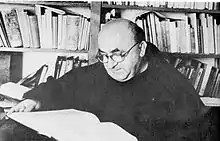
| Latin: Pontificia Academia Mariana Internationalis | |
| Type | Pontifical academy |
|---|---|
| Established | 1959 |
| Rector | Stefano Maria Cecchin |
| Location | |
| Website | www |
History
The Academy was established in July 1946 by the Order of Friars Minor with the specific task of organising scientific debates and conferences and caring for the publication of the Bibliotheca Mariana.[1] It was also responsible for studies relating to the dogma of the Immaculate Conception, on its first centenary. The first president of the Commission was Friar Charles Balic, who directed the Chair of Marian Studies at the Pontifical Atheneum Antonianum.
On December 8, 1959, Pope John XXIII, with the motu proprio Maiora in dies gave the Academy the title of “Pontifical”. In this way he instituted in it the permanent Committee charged with organizing the celebration of International Mariological and Marian Congresses. Said Committee, with the Statutes approved by Pope John Paul II, is the Council of the Academy.
Activities
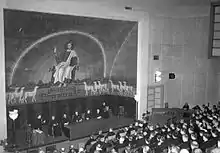
In 1950 the Academy gained international recognition with the organisation of the first International Mariological Congress and the eighth International Marian Congress. Congresses in 1948 and 1958 followed. The 23rd International Congress was held on September 4–9, 2012, and emphasized developments and new perspectives in contemporary Roman Catholic mariology (since Vatican Council II, after which it declined, and then was revived starting with the pontificate of Pope Paul VI).[2]
The work of PAMI has a twofold purpose: to promote and favor the scientific studies of the Virgin Mary, be they speculative or historical-critical, and to organize periodic Marian Conventions and Conferences. The results of which are edited and published in mariological collections, both historical and theological.
It is the will of the Papacy that it be an International, yet centralized body for the coordination of Mariological work in various nations and in the single scientific entities. This task of coordination was highlighted by the pontifical document of Pope John XXIII: “It is our desire that this our Academy continue, as it has up till now, to work for the friendly union of forces and intent of all other Marian Academies and Societies existing in the world so as to contribute to the praise and honor of the Virgin Mary.”
The PAMI also coordinates the teachers of mariology for which it organizes periodic meetings. [3]
Marian societies and academies
- Société Française d’Études Mariales (SFEM – Francia)
- Sociedad Mariológica Española (SME – Spagna)
- Mariological Society of America (USA)
- Deutsche Arbeitsgemeinschaft für Mariologie (Germania)
- Sociedad Mariológica Colombiana
- Polskie Towarzystwo Mariologiczne (Polonia)
- Hrvatski Mariološki Institut (Croazia)
- Associazione Mariologica Interdisciplinare Italiana (AMI)
- Ecumenical Society of the Blessed Virgin Mary (ESBVM – Inghilterra-Usa)
- Società Mariologica Mediorientale (Libano)
- Mariological Academy of India (India)
- Mariological Society of Philippines
Other Marian sections:
- Asiatic Section
- African Section
- Latin-American Section
- Slovenia Section
- Brazilian Section
Marian centres
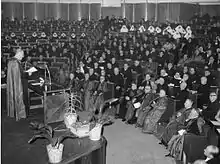
- Pontifical Theological Faculty Marianum (Rome)
- International Marian Research Institute (Dayton – USA)
- Marian Academy of Kolbe (Kolbianum) in Niepokalanow (Poland)
- Istituto Superiore di Scienze Religiose S. Maria di Monte Berico (Vicenza – Italy)
- Centro mariano de los Siervos de Maria (Mexico)
- Centrum Formacji Maryjnej “Salvatoris Mater” Księży Marianów (Poland)
- Academia Marial de Aparecida (Brasil)
- Marian Centre of Our Lady Ta’ Pinu Shrine (Gozo, Malta)
Mariological/Marian international congresses
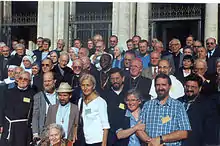
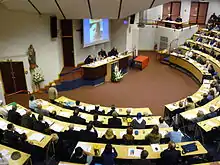
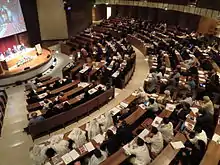
The PAMI has organized "Mariological International Congresses" since 1950, the occasion of the 8th Marian International Congress:
- 1950 – 1º Mariological – 8º Marian International Congress – Rome
- 1954 – 2º Mariological – 9º Marian International Congress – Rome
- 1958 – 3º Mariological – 10º Marian International Congress – Lourdes
- 1965 – 4º Mariological – 11º Marian International Congress – Santo Domingo
- 1967 – 5º Mariological – 12º Marian International Congress – Lisboa
- 1971 – 6º Mariological – 13º Marian International Congress – Zagreb
- 1975 – 7º Mariological – 14º Marian International Congress – Rome
- 1979 – 8º Mariological – 15º Marian International Congress – Zaragoza
- 1983 – 9º Mariological – 16º Marian International Congress – Malta
- 1987 – 10º Mariological – 17º Marian International Congress – Kevelaer
- 1992 – 11º Mariological – 18º Marian International Congress – Huelva
- 1996 – 12º Mariological – 19º Marian International Congress – Częstochowa
On January 8, 1996, John Paul II approved the revision of the statutes of the PAMI, leading to a change in the denomination of the congresses since 2000.
- 2000 – 20º Mariological Marian International Congress – Rome
- 2004 – 21º Mariological Marian International Congress – Rome
- 2008 – 22º Mariological Marian International Congress – Lourdes
- 2012 – 23º Mariological Marian International Congress – Rome
- 2016 – 24º Mariological Marian International Congress – Fátima
See also
- Global organisation of the Catholic Church
- Index of Vatican City-related articles
- Mariology
- Roman Catholic Mariology
- Virgin Mary
- The Pontifical Theological Faculty Marianum.
References
- "University of Dayton – History of PAMI". Archived from the original on 2012-01-13. Retrieved 2010-09-14.
- "Catholic News". Archived from the original on 2012-12-05. Retrieved 2012-09-08.
- Teachers